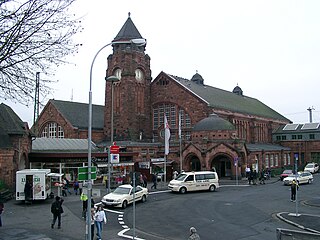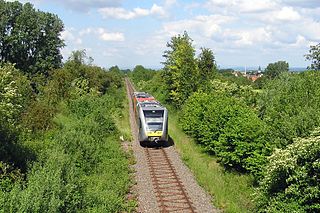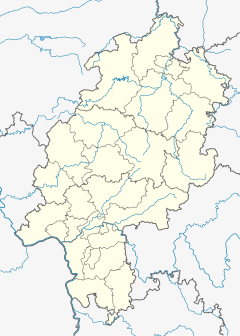The Rhine-Main Railway, is a railway line in southern Germany from Mainz via Darmstadt to Aschaffenburg. It was built by the Hessian Ludwig Railway and opened on 1 August 1858 and is one of the oldest railways in Germany. Until 1862, when the railway bridge over the Rhine river constructed and assembled by MAN-Werk Gustavsburg was finished, a train ferry operated on the river.

The Main–Weser Railway is a railway line in central Germany that runs from Frankfurt am Main via Gießen to Kassel. it is named after the railway company that built the line and also operated it until 1880. It was opened between 1849 and 1852 and was one of the first railways in Germany.

Marburg (Lahn) station is a through station at the 104.3 km mark of the Main-Weser Railway in the north-east of the city of Marburg in the German state of Hesse and is used daily by about 12,000 people. The station is classified by Deutsche Bahn (DB) as a category 3 station.

Gießen railway station is the main railway station in Gießen, Hesse, Germany. The station is a Category 2 station is used by 20,000 passengers daily. The station was opened on 25 August 1850 and is located on the Main-Weser Railway and Dill railway. The current station reception building was built between 1904 and 1911. The main original station building is a historic landmark and has been protected. Outside the station is a bus station and a taxi rank. Parking garages are located nearby.
The Bebra–Baunatal-Guntershausen railway is a two-track, electrified main line in the German state of Hesse, connecting Kassel with Bebra and Gerstungen on the border with Thuringia, as well as with Bad Karlshafen (formerly) and Warburg on the border with Westphalia. It was originally part of the Friedrich-Wilhelms-Nordbahn, which was completed in 1849. It was one of the first railway lines in the Electorate of Hesse and in Germany.

The Homburg Railway is an 18 km line from Frankfurt am Main to Bad Homburg in the German state of Hesse. It was opened in 1860 as one of the first railway lines in Germany. It is now part of the Rhine-Main S-Bahn line S5 to Friedrichsdorf.
The Friedberg–Hanau railway is a 32.2 km long double-track, electrified mainline in the German state of Hesse. It connects Friedberg and Hanau. The line has the timetable number of 633 and it is integrated in the Rhein-Main-Verkehrsverbund as Regionalbahn service RB 49.

Friedrichsdorf (Taunus) station is in the centre of Friedrichsdorf on Bahnstraße. Although the city has mostly dispensed with the appendage of "Taunus" in its name the station still officially retains it, although signs on the newest platform and Rhein-Main-Verkehrsverbund maps do not include it. The station is classified by Deutsche Bahn as a category 4 station.

Groß Karben station is a station at the 178.4 km mark on the Main–Weser Railway from Kassel via Marburg and Giessen to Frankfurt in the German state of Hesse. It is located approximately one kilometre from Groß Karben, now a district of Karben, and is located on the outskirts of the Karben district of Kloppenheim. Unlike the district of Groß-Karben, it is spelled without a hyphen. The station is classified by Deutsche Bahn as a category 5 station.

Steinheim (Main) station is a station on the Frankfurt Schlachthof–Hanau railway in Hanau in the German state of Hesse. The station is classified by Deutsche Bahn (DB) as a category 5 station.

Bad Nauheim station is a station in the town of Bad Nauheim in the German state of Hesse on the Main–Weser Railway. The station is classified by Deutsche Bahn (DB) as a category 4 station.

Langenselbold station is a station in the town of Langenselbold in the German state of Hesse on the Frankfurt–Göttingen railway. The station is classified by Deutsche Bahn (DB) as a category 4 station.

Cölbe station is a junction station on the Main-Weser Railway in the town of Cölbe in the German state of Hesse. Here the Upper Lahn Valley Railway to Erndtebrück via Biedenkopf and Bad Laasphe and the Burgwald Railway to Frankenberg (Eder) via Wetter and Münchhausen branch off the main line. It has four platform tracks and a passing loop. The station is classified by Deutsche Bahn (DB) as a category 5 station. The Baroque Revival station is heritage-listed under the Hessian Heritage Act.

Kirchhain station is a through station at the 89.2 km mark on the Main-Weser Railway. It is located very centrally in the centre of the town of Kirchhain in the German state of Hesse. Formerly, the station was the starting point of the Ohm Valley Railway to Burg- und Nieder-Gemünden and the Wohra Valley Railway (Wohratalbahn) to Gemünden (Wohra). The station is classified by Deutsche Bahn (DB) as a category 4 station.

Nidderau station is a junction station on the Friedberg–Hanau railway and the Nidder Valley Railway in the town of Nidderau in the German state of Hesse. The station is classified by Deutsche Bahn (DB) as a category 5 station.

Hungen station is a station on the Gießen–Gelnhausen railway in the town of Hungen in the German state of Hesse. From 1 June 1890 to 4 April 2003, the Friedberg–Mücke railway branched off to Mücke via Laubach and to Friedberg via Wölfersheim and Beienheim. The station is classified by Deutsche Bahn (DB) as a category 6 station.

Frankfurt-Mainkur station is located on the Frankfurt Süd–Aschaffenburg railway between Frankfurt East station and Hanau Hauptbahnhof in the Frankfurt district of Fechenheim in the German state of Hesse. The station is classified by Deutsche Bahn (DB) as a category 5 station.

Bad Vilbel station is located at the 183.6 kilometre mark of the Main-Weser Railway in the town of Bad Vilbel in the German state of Hesse. The Nidder Valley Railway branches from Bad Vilbel via Nidderau to Glauburg-Stockheim. It is classified by Deutsche Bahn as a category 3 station.

The Friedberg–Mücke railway is a railway that was opened in 1890/97 in the Wetterau and Vogelsberg regions in the German state of Hesse. Sections of the line are also called the Horlofftalbahn and the Seentalbahn. It originally connected three major railways that run from Giessen, namely:

The Friedrichsdorf–Friedberg railway is a single-track, non-electrified branch line in the German state of Hesse. It is listed as timetable route 636 and integrated in the Rhein-Main-Verkehrsverbund as line 16.























